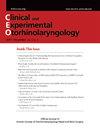Clinical and Laboratory Features of Various Criteria of Eosinophilic Chronic Rhinosinusitis: A Systematic Review and Meta-Analysis
IF 2.9
3区 医学
Q1 OTORHINOLARYNGOLOGY
引用次数: 34
Abstract
Objectives The aim of this study was to evaluate the differences in clinical and laboratory features between eosinophilic chronic rhinosinusitis (ECRS) and non-ECRS and to compare diagnostic criteria for ECRS. Methods We compared clinical features and/or laboratory findings classified as ECRS and non-ECRS according to various diagnostic criteria (histological and clinical). We also analyzed studies to compare endoscopic findings, symptom scores, laboratory findings, and computed tomography (CT) findings between ECRS and non-ECRS. Results Our search included 55 studies with 6,143 patients. A comparison of clinical features and/or laboratory criteria with histological criteria showed no significant differences in nasal symptom scores and CT scores according to criteria. Serum eosinophil levels showed differences across the criteria, with ECRS consistently characterized by higher serum eosinophil levels than non-ECRS. Among the four criteria, the Japanese Epidemiological Survey of Refractory Eosinophilic Chronic Rhinosinusitis (JESREC) criteria and tissue eosinophilia (≥70) were associated with decreased olfactory function. In laboratory findings, the eosinophil percentage (standardized mean difference [SMD], 1.561; 95% confidence interval [CI], 1.329–1.794; P<0.001) and eosinophil count (SMD, 1.493; 95% CI, 1.134–1.852; P<0.001) of eosinophils were higher in ECRS than non-ECRS. In clinical findings, nasal symptom scores (SMD, 0.382; 95% CI, 0.156–0.608; P<0.001), endoscopic nasal polyp scores (SMD, 0.581; 95% CI, 0.314–0.848; P<0.001), and olfactory dysfunction (SMD, 0.416; 95% CI, 0.037–0.794; P=0.031) were higher in ECRS than in non-ECRS. With regard to CT findings, the whole-sinus opacification score (SMD, 0.824; 95% CI, 0.588–1.059; P<0.001) was higher in ECRS than in non-ECRS. In particular, there were significant differences in anterior ethmoid sinus and sphenoid sinus opacification. Conclusion ECRS and non-ECRS differ in their clinical and laboratory features. When histological confirmation is difficult on an outpatient basis, ECRS could be diagnosed using clinical features and/or laboratory findings.嗜酸性粒细胞性慢性鼻窦炎不同诊断标准的临床和实验室特征:系统评价和Meta分析
目的本研究的目的是评估嗜酸性慢性鼻窦炎(ECRS)和非ECRS在临床和实验室特征上的差异,并比较ECRS的诊断标准。方法根据不同的诊断标准(组织学和临床),我们比较了分类为ECRS和非ECRS的临床特征和/或实验室结果。我们还分析了比较ECRS和非ECRS的内镜检查结果、症状评分、实验室检查结果和计算机断层扫描(CT)结果的研究。结果我们的检索包括55项研究,6143名患者。临床特征和/或实验室标准与组织学标准的比较显示,根据标准,鼻腔症状评分和CT评分没有显著差异。血清嗜酸性粒细胞水平显示出不同标准的差异,ECRS的特征始终是血清嗜酸性细胞水平高于非ECRS。在这四项标准中,日本难治性嗜酸性粒细胞慢性鼻窦炎流行病学调查(JESREC)标准和组织嗜酸性粒增多症(≥70)与嗅觉功能下降有关。在实验室检查中,ECRS中的嗜酸性粒细胞百分比(标准化平均差[SMD],1.561;95%置信区间[CI],1.329-1.794;P<0.001)和嗜酸性粒细胞核计数(SMD,1.493;95%CI,1.134-1.852;P=0.001)高于非ECRS。在临床发现中,鼻症状评分(SMD,0.382;95%CI,0.156–0.608;P<0.001)、鼻内镜下鼻息肉评分(SMD,0.581;95%CI,0.314–0.848;P<0.001。关于CT表现,ECRS的全窦混浊评分(SMD,0.824;95%CI,0.588–1.059;P<0.001)高于非ECRS。特别是在筛前窦和蝶窦混浊方面存在显著差异。结论ECRS和非ECRS的临床和实验室特征不同。当在门诊基础上难以进行组织学确认时,可以使用临床特征和/或实验室结果来诊断ECRS。
本文章由计算机程序翻译,如有差异,请以英文原文为准。
求助全文
约1分钟内获得全文
求助全文
来源期刊
CiteScore
4.90
自引率
6.70%
发文量
49
审稿时长
6-12 weeks
期刊介绍:
Clinical and Experimental Otorhinolaryngology (Clin Exp Otorhinolaryngol, CEO) is an international peer-reviewed journal on recent developments in diagnosis and treatment of otorhinolaryngology-head and neck surgery and dedicated to the advancement of patient care in ear, nose, throat, head, and neck disorders. This journal publishes original articles relating to both clinical and basic researches, reviews, and clinical trials, encompassing the whole topics of otorhinolaryngology-head and neck surgery.
CEO was first issued in 2008 and this journal is published in English four times (the last day of February, May, August, and November) per year by the Korean Society of Otorhinolaryngology-Head and Neck Surgery. The Journal aims at publishing evidence-based, scientifically written articles from different disciplines of otorhinolaryngology field.
The readership contains clinical/basic research into current practice in otorhinolaryngology, audiology, speech pathology, head and neck oncology, plastic and reconstructive surgery. The readers are otolaryngologists, head and neck surgeons and oncologists, audiologists, and speech pathologists.

 求助内容:
求助内容: 应助结果提醒方式:
应助结果提醒方式:


